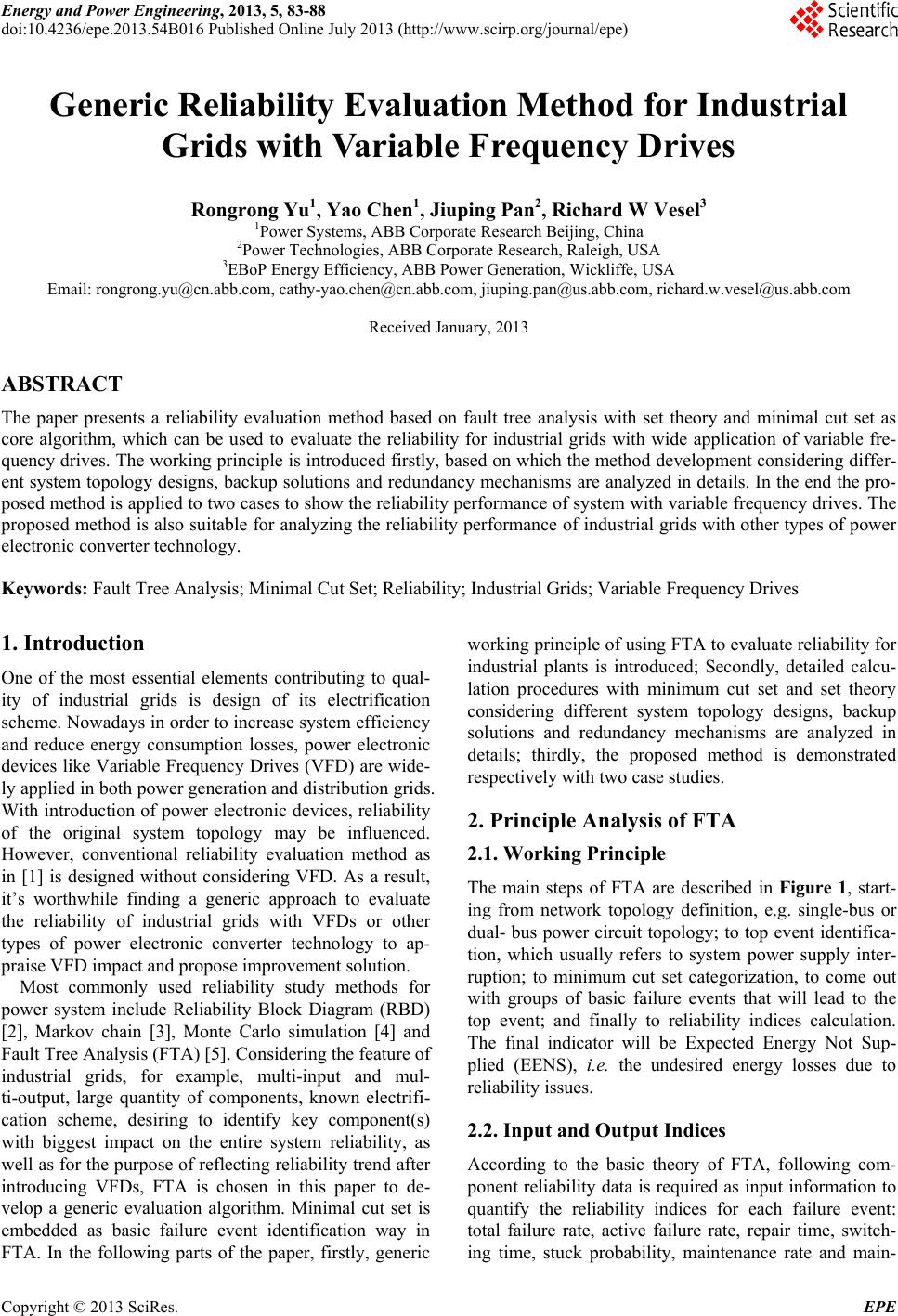
Energy and Power Engineering, 2013, 5, 83-88
doi:10.4236/epe.2013.54B016 Published Online July 2013 (http://www.scirp.org/journal/epe)
Generic Reliability Evaluation Method for Industrial
Grids with Variable Frequency Drives
Rongrong Yu1, Yao Chen1, Jiuping Pan2, Richard W Vesel3
1Power Systems, ABB Corporate Research Beijing, China
2Power Technologies, ABB Corporate Research, Raleigh, USA
3EBoP Energy Efficiency, ABB Power Generation, Wickliffe, USA
Email: rongrong.yu@cn.abb.com, cathy-yao.chen@cn.abb.com, jiuping.pan@us.abb.com, richard.w.vesel@us.abb.com
Received January, 2013
ABSTRACT
The paper presents a reliability evaluation method based on fault tree analysis with set theory and minimal cut set as
core algorithm, which can be used to evaluate the reliability for industrial grids with wide application of variable fre-
quency drives. The working principle is introduced firstly, based on which the method development considering differ-
ent system topology designs, backup solutions and redundancy mechanisms are analyzed in details. In the end the pro-
posed method is applied to two cases to show the reliability performance of system with variable frequency drives. The
proposed method is also suitable for analyzing the reliability performance of industrial grids with other types of power
electronic converter technology.
Keywords: Fault Tree Analysis; Minimal Cut Set; Reliability; Industrial Grids; Variable Frequency Drives
1. Introduction
One of the most essential elements contributing to qual-
ity of industrial grids is design of its electrification
scheme. Nowadays in order to increase system efficiency
and reduce energy consumption losses, power electronic
devices like Variable Frequency Drives (VFD) are wide-
ly applied in both power generation and distribution grids.
With introduction of power electronic devices, reliability
of the original system topology may be influenced.
However, conventional reliability evaluation method as
in [1] is designed without considering VFD. As a result,
it’s worthwhile finding a generic approach to evaluate
the reliability of industrial grids with VFDs or other
types of power electronic converter technology to ap-
praise VFD impact and propose improvement solution.
Most commonly used reliability study methods for
power system include Reliability Block Diagram (RBD)
[2], Markov chain [3], Monte Carlo simulation [4] and
Fault Tree Analysis (FTA) [5]. Considering the feature of
industrial grids, for example, multi-input and mul-
ti-output, large quantity of components, known electrifi-
cation scheme, desiring to identify key component(s)
with biggest impact on the entire system reliability, as
well as for the purpose of reflecting reliability trend after
introducing VFDs, FTA is chosen in this paper to de-
velop a generic evaluation algorithm. Minimal cut set is
embedded as basic failure event identification way in
FTA. In the following parts of the paper, firstly, generic
working principle of using FTA to evaluate reliability for
industrial plants is introduced; Secondly, detailed calcu-
lation procedures with minimum cut set and set theory
considering different system topology designs, backup
solutions and redundancy mechanisms are analyzed in
details; thirdly, the proposed method is demonstrated
respectively with two case studies.
2. Principle Analysis of FTA
2.1. Working Principle
The main steps of FTA are described in Figure 1, start-
ing from network topology definition, e.g. single-bus or
dual- bus power circuit topology; to top event identifica-
tion, which usually refers to system power supply inter-
ruption; to minimum cut set categorization, to come out
with groups of basic failure events that will lead to the
top event; and finally to reliability indices calculation.
The final indicator will be Expected Energy Not Sup-
plied (EENS), i.e. the undesired energy losses due to
reliability issues.
2.2. Input and Output Indices
According to the basic theory of FTA, following com-
ponent reliability data is required as input information to
quantify the reliability indices for each failure event:
total failure rate, active failure rate, repair time, switch-
ing time, stuck probability, maintenance rate and main-
Copyright © 2013 SciRes. EPE